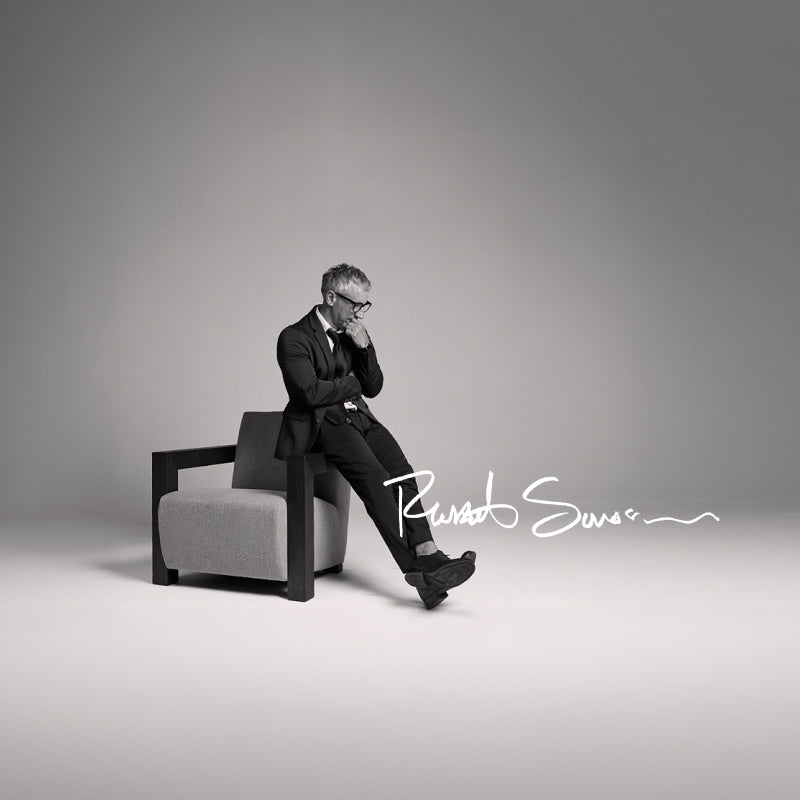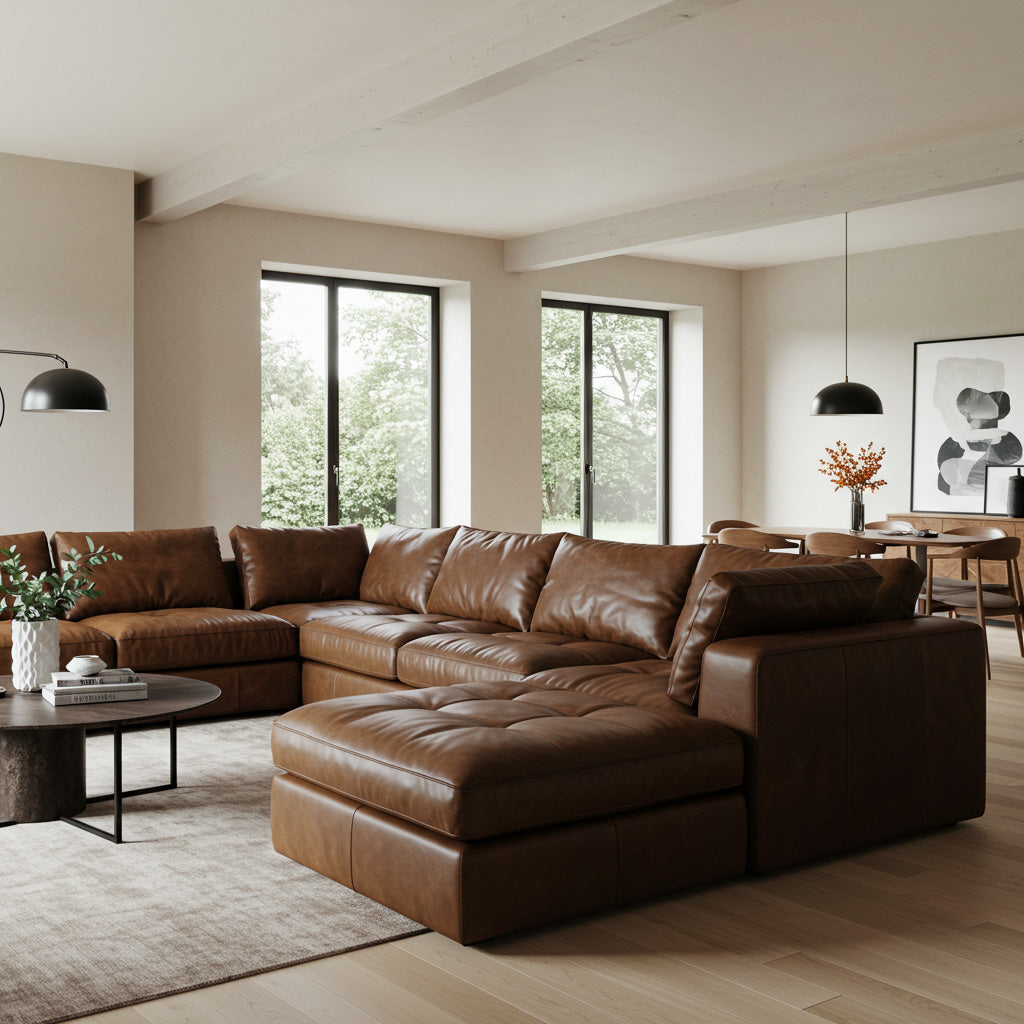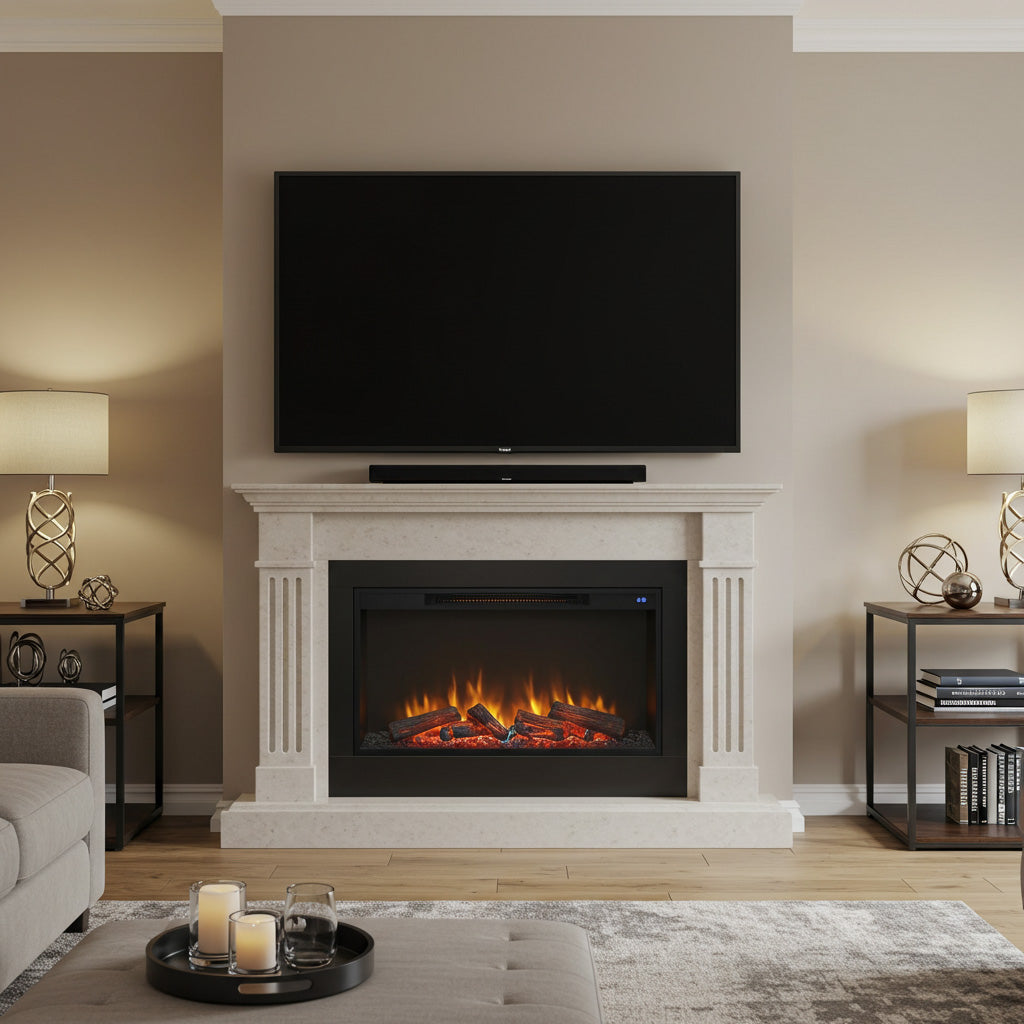Leather furniture brings timeless appeal and sophistication to any room. While these pieces often represent a significant investment, they can last for decades with proper care.
any owners worry about cleaning it correctly and fear causing damage. Yet, proper care is essential to keep your leather looking fresh and beautiful.
This guide will walk you through essential cleaning techniques, from basic upkeep to tackling specific stains, ensuring your leather furniture stays looking luxurious for years.
What You'll Need
- Microfiber Cloths
- Vacuum Cleaner with Soft Brush Attachment
- Distilled Water
- Small Buckets or Bowls
- Mild & non-detergent soap
- Soft-Bristled Brush
What Should You Not Use on Leather?
Certain products should never be used on leather furniture as they can cause serious damage. They should be avoided:
Bleach and Ammonia-Based Cleaners
These harsh chemicals can fade and dry out leather, damaging the fibers and weakening the material.
Furniture Polish
Regular furniture polish isn't made for leather surfaces. It creates a sticky buildup that attracts dust and can leave stubborn stains. Unlike leather care oils, these products don't provide the nourishment leather needs to stay supple.
Abrasive Cleaners
Any cleaner with rough particles will harm your leather furniture. These products scratch the surface and wear down the protective finish that keeps your leather looking good.
Alcohol-Based Wipes & Sprays
The alcohol in these products acts as a solvent. It can strip away the protective surface layer of your leather, leading to fading and reduced protection against wear and tear.
Saddle Soap
Saddle soap is too alkaline for leather furniture and can darken the leather or leave residues.
Steam Cleaners
The heat and moisture from steam cleaning can destroy leather's natural oils. This leads to premature aging, cracking, and permanent damage to your furniture.

This Lydia Chair with Ottoman Set features easy-to-clean faux leather upholstery for a luxurious feel.
How to Clean Leather Furniture Naturally?
- Vacuum: Vacuum the entire surface thoroughly with a soft brush attachment. Pay special attention to seams, creases, and areas under cushions.
- Spot Test: Always test any cleaning solution on a small, inconspicuous area first (e.g., under a cushion). Allow it to dry completely before proceeding.
- Prepare Solution: Mix a small amount of neutral or mild non-detergent soap with distilled water, or use a cleaner designed for leather.
- Dampen Cloth: Dip a clean microfiber cloth into the solution, then wring it out thoroughly until the cloth is damp but not dripping.
- Wipe Gently: Wipe the leather in small sections. Use circular motion and apply gentle pressure to remove dirt, especially on high-use areas like armrests.
- Rinse: Use a second microfiber cloth, dampened with clean distilled water, to remove any soap residue. Make sure the cloth is damp, not wet.
- Dry: Immediately use a third clean, dry microfiber cloth to gently dry the leather surface.
- Air Dry: Let the furniture air dry completely before using it. Avoid direct heat or sunlight during the drying process.
How to Remove Stubborn Stains From Leather?
Accidents happen, and the longer stains remain, the deeper they penetrate, making them more difficult to remove.
Prompt and proper handling can often prevent minor stains from becoming permanent marks on leather furniture.
Water Stains
Ironically, water itself can stain some types of leather. To address this, gently moisten the stained area with a cloth dampened in distilled water.
Absorb moisture from the seams, and let the area air dry naturally, away from heat or sunlight.
Grease & Oil Stains
For grease stains, blot right away with a clean, dry cloth. Don't use water, as it will make the oil soak into the leather. Cover the stain with cornstarch or baking soda powder. Leave it for hours or overnight to soak up the oil.
Brush or vacuum off the powder, repeat if needed. For tough stains, you might need a leather degreaser.
Ink Stains
Ink is hard to remove from leather. You usually need a pro to get it out fully. For fresh stains, try blotting gently with a cotton swab dipped in isopropyl alcohol.
Test it on a hidden spot first, as it can remove the leather's color. Blot gently, don't rub hard.
Food & Drink Stains
Act fast and blot well. Some say to try a mix of lemon juice and toothpaste. Put it on the stain for 10 minutes, then wipe with a damp cloth. Test first, as acid can change the color.
For red wine, blot and wash with mild soap. If that doesn't work, spray with half vinegar, half water. Wait, then blot dry.
Mold & Mildew
Mix equal parts alcohol and water. Wipe the area with this mix on a cloth. Then wipe with a clean, damp cloth. Make sure it dries fully and fix what's causing the dampness.
Dye Transfer
This happens when dyes from clothes rub off on leather. It's hard to remove. Mild soap or vinegar might not work.
Use leather cleaners or dye removers, but they might not get it all out. It's best to prevent it with stain-resistant pads.
Mud
Let the mud dry completely before brushing off with a soft brush. Clean leftover stains with mild soap, wipe with a damp cloth, and dry. Use conditioner if needed.
Road Salt
Salt, often from shoes, can transfer to furniture. Wipe stains with a cloth dampened in a 1:1 vinegar and water solution. Do this more than once if needed. Wipe with a clean, damp cloth, let it dry, then use conditioner.

The Brentwood Storage Ottoman Bench pictured above is covered with faux leather fabric and decorated with studded button details on the top, giving it a luxurious feel.
How to Condition Leather?
Conditioning leather furniture is as crucial as cleaning it. Leather contains natural oils that keep it supple and prevent drying.
Over time, cleaning and environmental factors like low humidity and sunlight can deplete these oils.
Conditioning replenishes these oils, keeping leather soft and resistant to cracking. It also forms a protective layer against minor spills and stains.
Regular conditioning is important for maintaining your leather furniture's health and appearance.
Choosing the Right Conditioner
When picking a leather conditioner, look for high-quality products with natural ingredients. High-quality conditioners often have natural ingredients like lanolin or beef tallow. These help with leather absorption and nourishment.
Stay away from conditioners that have petroleum distillates, silicones, or heavy waxes. These can harm your leather by clogging pores and creating a greasy feel.
While homemade conditioners might seem appealing, they can be risky. For reliable results, stick to professionally made commercial leather conditioners. They're safer and more effective, giving you consistent outcomes every time you use them.
How to Apply Conditioner?
- Clean and dry the leather thoroughly. This prevents sealing in dirt or trapping moisture.
- Apply a small amount of conditioner to a clean microfiber cloth. Don't put it directly on the leather to avoid uneven absorption.
- Gently massage the conditioner into the leather using circular motions. Work in sections, even for coverage.
- Allow time for the conditioner to absorb. This can take 10 minutes to several hours, depending on the product and leather condition.
- Wipe the surface with a clean, dry microfiber cloth to remove excess product and restore shine.
- Let the leather item sit before use to prevent product transfer to clothing.
How Often to Clean Leather Furniture?
Dusting & Vacuuming
Keeping your leather furniture clean starts with regular dusting and vacuuming. You should remove dust, debris, and pet hair at least once a week.
Use a clean, dry microfiber cloth or a vacuum with a soft brush attachment. Pay special attention to seams and crevices where dirt often builds up. This helps remove abrasive particles that could scratch the leather over time.
Wipe-Down
For a more thorough clean, do a light wipe-down every two to four weeks, depending on how often you use the furniture. Gently wipe the entire piece with a microfiber cloth dampened with distilled water.
Remember to use a slightly damp cloth, not a soaking wet one. Wring it out well before wiping. This helps remove fine dirt and oils that dusting alone might miss, without soaking the leather.
Deep Clean
While daily care keeps your leather looking good, deep cleaning is crucial for removing stubborn dirt and keeping the leather soft. This process helps prevent drying and cracking, maintaining that luxurious look.
Aim to deep clean every 6 to 12 months. For furniture in high-traffic areas, used by pets or kids, or light-colored leather, you might need to do this more often, like every 3-6 months. Regular care will keep your leather furniture looking great for years to come.

Conclusion
Maintaining leather furniture isn't as hard as you might think. With a few simple steps, you can keep your leather looking great for years.
Regular cleaning, quick spill cleanup, and proper care are key. These habits protect your investment and help your furniture age gracefully.
By following this guide, you can feel confident in caring for your leather pieces. Over time, they'll develop a unique style and become a cozy focal point in your home.
With the right know-how, you can enjoy your leather furniture's luxury and comfort for a long time to come.
FAQs
What If the Leather Accent Chairs Look Worse After Cleaning?
If your leather accent chairs look worse after cleaning, don't panic. This can happen for a few reasons, like using too much water, using unsuitable products, or uneven application.
Try gently wiping the area with a clean cloth dampened with distilled water, then dry it with another clean cloth. If the problem persists, stop and call a professional leather cleaner.
What Do You Do When You Notice the Leather Fading?
Leather fading is often caused by direct sunlight. Move your furniture away from sunny spots right away. Minor fading can be improved with proper care.
But if it's bad, you'll need a pro or a special leather re-coloring kit or cream. Regular care can help prevent fading. Regular maintenance and avoiding direct sunlight can help prevent future fading.
What to Do If the Leather Feels Stiff or Dry?
If your leather feels stiff or dry, it's likely lost its natural oils. This means it's time for some care. Follow the deep cleaning and conditioning steps we covered earlier.
For very dry leather, you might need to apply conditioner a few times over several days. This process will help bring back the softness and suppleness of your leather item.
How to Deal with Lingering Odors?
Sprinkle baking soda on the leather and under cushions. Let it sit for hours or overnight, then vacuum thoroughly. Be careful, as prolonged contact may dry out the leather.
You can also wipe with a 1:1 mix of white vinegar and distilled water to neutralize odors. Remember to care for the leather afterward.
Always try to find and fix the odor source. For stubborn smells, consider using activated charcoal or leaving coffee grounds in the area to absorb odors naturally.
Related:






















Leave a comment
This site is protected by hCaptcha and the hCaptcha Privacy Policy and Terms of Service apply.